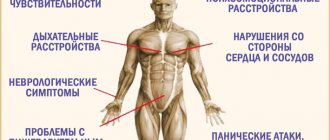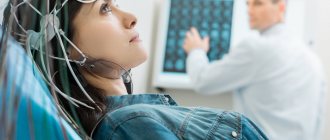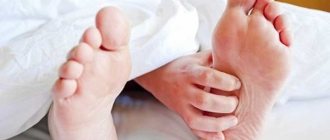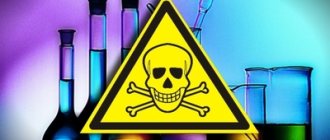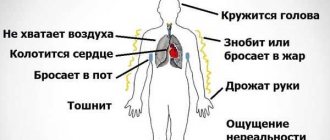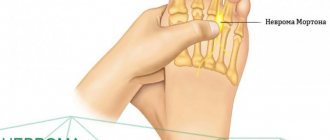Benign myoclonic epilepsy of infancy
(DMEM) is an age-dependent form of idiopathic epilepsy that is characterized by generalized myoclonic seizures. The etiology has not been studied in detail. The pathology is manifested by muscle contractions of the upper limbs, neck and head lasting 1-3 seconds. with a frequency of 2-3 times a day. The general condition of the child and his psychophysical development are rarely disturbed. Diagnostics is aimed at identifying spike or polyspike waves on the EEG. The main treatment is drug monotherapy. The drugs of choice are valproates; if they are ineffective, benzodiazepines or succinimide derivatives are used.
Case history and nomenclature
Benign myoclonic epilepsy syndrome in children (BMSES) was not clearly defined until it was first described in 7 young children in 1981 (Drave and Bior, 1981).
In this article, SDMED was defined as the occurrence of myoclonic seizures (MS) without seizures other than simple febrile seizures (FS) in the first three years of life in healthy children. These MPs were easily treatable and became quite rare during subsequent years of childhood. Psychomotor development remained normal, and no severe psychological consequences were observed. Since then, many other cases have been described in the literature. SDMED is included in the 1989 International Classification of Generalized Idiopathic Epilepsies (Commission, 1989). Some authors have described reflex MP in patients caused by noise or conversation, and proposed to distinguish between two separate nosological forms, and the 2nd was called reflex myoclonic epilepsy in children (Ricci et al., 1985). We think that such a division is inappropriate and will describe all cases as SDMED. To our knowledge, 98 cases have been described in the literature to date, of which 88 fit the classic description of SDMED and 10 were defined as “reflex SDMED.”
There are now 5 new patients under our supervision, four of whom have spontaneous and reflex seizures, which brings the total number of patients to 103.
The first description of SDMED indicated that the onset of the disease was before 3 years of age, while subsequent reports suggested a later onset in some patients, up to 4 years 8 months (Giovanardi-Rossi et al., 1997). This means that epilepsy of the same type can appear at different ages (Guerini et al., 1997).
Causes
Like most forms, the origin of myoclonic epilepsy is a mystery. There are several factors that provoke the development of the disease:
- The presence of absence seizures increases the risk by 7 times;
- Heredity;
- Genetic defects.
The attack itself, in addition to the spontaneous onset, develops under the influence of:
- Lack of sleep;
- Excessive alcohol consumption;
- Flickering light;
- Increased concentration on something.
General provisions
Epidemiology
According to the few epidemiological data available, SDMED accounts for less than 1% of all epilepsies (St. Paul's Center, 1997), 1.3% and 1.72% of epilepsies that begin in the first year of life (Dalla Bernardina et al., 1983). , and 0.39% of epilepsies beginning in the first 6 years of life (Ohtsuka et al., 1993).
Floor
Gender distribution: 52 boys and 27 girls.
Genetics
The genetics of SDMED are unknown. There are few patients, and cases of familial SDMED have not been described. A family history of epilepsy or febrile seizures (AF) was present in 39% of 80 patients. In 70 patients, the incidence of AF in the family was 17%, and the incidence of epilepsy was 24%. It is difficult to assess the type of epilepsy found in relatives. In 10 cases it was probably idiopathic epilepsy. In the case reported by Arzimanoglou et al (1996), the proband was the 2nd of 2 brothers, and the eldest suffered from typical epilepsy with myoclonic-astatic seizures (EMAS, Douz syndrome).
Anamnesis of life
Most patients had no history of pathology before the onset of MP. Only two (1.9%) had comorbidities: Douz syndrome (Drave et al., 1992) and hyperinsulin diabetes (Colamaria et al., 1987).
However, cases of AF are not rare: 19 out of 64 patients (30%). AFs were always simple, but rare (1-2) and were observed before the onset of myoclonus and before the start of treatment (15 cases).
Definition
This form of the disease is often called juvenile epilepsy, because it occurs in children or young people between 8 and 24 years of age. The peak occurs between the ages of 12 and 18. It is briefly called JME. Which stands for juvenile myoclonic epilepsy. Subspecies include:
- Children's benign myoclonus;
- West syndrome;
- Lafora's disease.
This type of epilepsy was first mentioned in 1867 by Janz. But the pathology was officially identified only in 1955. ICD-10 classifies the disease as class G40.8.
Clinical and EEG manifestations
The age at which the disease begins is usually from 4 months to 3 years. Rarely does it start earlier. Later onset was reported by Giovanardi-Rossi et al (1997) - 4 years 9 months - and Lin et al (1998) - 3 years 9 months.
At first, MPs are short, most often sparse, involving the upper limbs and head, and rarely the lower limbs. In infants they are subtle and parents sometimes find it difficult to determine their onset and frequency. They often talk about "spasms" or "head bobbing." Later, the frequency of attacks increases.
Video-EEG recordings allowed us to conduct a precise analysis of these seizures. These are more or less massive myoclonic jerks affecting the trunk and limbs, causing tilting of the head and upward and outward movement of the upper limbs with flexion of the lower limbs, and sometimes rotation of the eyeballs. Their intensity is different for each child; in the same patient it can change with each attack. In severe forms, objects suddenly fall out of the hands, and sometimes the patient falls. In moderate forms, only a short forward movement of the head or even a simple closing of the eyes is noted; as a rule, the seizures are very short (1-3 sec.), although they can last longer (in older children) and consist of pseudorhythmic twitchings that do not last. more than 5-10 sec. They develop several times a day at different intervals. Unlike childhood spasms, they do not occur in long series and do not develop at the moment of awakening, but rather during sleep. In some patients, sudden noise, sudden contact, or repeated photostimulation (RPS) can trigger seizures. With single seizures, it is difficult to assess the state of consciousness. Only with repeated seizures is there a slight disturbance of consciousness without interruption of activity. We did not observe the sudden short vocalisms reported by Lin et al. (1998). The authors point to the involvement of the diaphragm and/or abdominal muscles in the pathological process, causing expiratory noise. In reflex MP, myoclonus can be induced during both wakefulness and sleep, the excitability threshold is low in stage 1, but it gradually increases during the slow stages (Ricci et al., 1995). In patients with reflex MP, the REM sleep phase was not recorded or analyzed. Because The child’s development is normal, parents and pediatricians mistake these movements for pathology.
The EEG picture outside the attack is within normal limits.
Myoclonus is always associated with an EEG discharge. Recordings show that myoclonus is accompanied by a discharge of fast generalized spike waves (SW) or polyspike waves (PSW) with a frequency of more than 3 Hz, with the same duration as myoclonus. This is a more or less regular discharge and can begin in the frontal areas and in the vertex. Myoclonus is short (1-3 seconds) and usually isolated. The myoclonic jerk may be followed by brief atonia. Sometimes after an attack, voluntary movements appear, regarded as normal muscle contractions. And in only one patient we noted a combination of myoclonus in the deltoid muscle with pure atony of the cervical muscles. During drowsiness, myoclonus increases, but not always. They disappear during slow-wave sleep. MPs caused by tactile and auditory stimuli have the same characteristics. Ricci et al. (1995) indicate that the primary manifestations are usually, but not always, manifested only by the blink symptom, followed by 40-80 ms. followed by a myoclonic jerking of the arm. After a myoclonic attack, a refractory period begins, lasting from 20-30 seconds. up to 1-2 minutes, during which external stimuli, even fear, do not provoke attacks. Repeated photostimulation (RP) can also provoke MP (Drave et al., 1992; Todt and Müller, 1992; Giovanardgi-Rossi et al., 1997; Lin et al., 1998).
Interictal EEG data without pathology. Spontaneous SV discharges are rare; Slow waves can be detected in the central areas of the brain. PF causes SV without existing concomitant myoclonus. Short nap recordings showed normal sleep organization; generalized SV discharges may appear during REM sleep.
Diagnostics
To document the presence of the disease, the doctor needs to evaluate the symptomatic picture, collect an anamnesis, determine whether the pathology could be inherited by the child, and also conduct special studies. These include:
- Electroencephalography (EEG) is the “gold” standard in the diagnosis of epilepsy. It is provided by recording the electrical activity of the brain. Sometimes provoking factors are used to cause an attack, for example, light irritation, and the disorder is recorded;
- Magnetic resonance imaging (MRI), which allows to detect changes in the structure of brain tissue;
- Computed tomography (CT) is a method similar to MRI, but not as informative regarding soft tissues. However, it is faster to carry out.
The doctor must differentiate between myoclonic limb spasms that occur in healthy people and epilepsy. The key point is the frequency of seizures, the presence of absence seizures and the prevalence of the process.
Course and treatment
Children with SDMED do not experience seizures of any other type, even if they remain untreated (up to 8.5 years in one of our patients), this is especially true for petit epileptic or tonic seizures. Clinical examination results are normal. Interictal myoclonus was described only by Giovanardi-Rossi et al. (1997) in 6 patients. Analyzing the condition of our patients, we found mild interictal myoclonus in 2 according to EEG recordings. Many patients were not examined, but when CT and MRI were performed, the results were normal (33 patients).
Outcome likely depends on early diagnosis and treatment. Myoclonus is easily amenable to monotherapy with valproate, and the child’s development is appropriate for his age. If left untreated, the patient continues to have myoclonic seizures, which can lead to impaired psychomotor development and behavioral abnormalities.
Treatment methods were more or less thoroughly tested on 74 patients. 65 patients received monotherapy, 6 received polytherapy, and 3 received no treatment. Monotherapy included valproate (VPA), phenobarbital (PB), nitrazepam (NTZ). 6 patients received therapy with primidone (PRM) and ethosuximide (ESM). As a result of treatment, seizures disappeared in 69 patients (93%).
These data confirm that VPA is the first choice drug for SDMED. However, treatment should be carried out under the control of drug concentration in plasma, because improper use may lead to relapse or cause drug-resistant epilepsy.
Types of myoclonic epilepsy
Myoclonic epilepsy is a brain disease accompanied by seizures. The disease can manifest itself in several types of seizures:
- Myoclonic, in which the arms twitch in the morning after getting out of bed. If a person is very tired, seizures occur in the evening.
- Tonic-clonic. Over 70% of patients with juvenile myoclonic epilepsy experience such seizures. Their appearance in most situations is caused by an incorrect daily routine.
- Absence seizures. The patient loses consciousness for several seconds, and there is no convulsive activity. Absence seizures occur regardless of the time of day and are diagnosed in 1/3 of patients.
Only in a hospital will doctors be able to determine the type of attacks. Photostimulation is the best way to diagnose the disease.
Long-term results and prognosis
The duration of observation for 63 patients was 9 months. up to 27 years, of which 45 patients were observed for about 5 years. The age of patients during the observation period ranged from under 5 to over 15 years.
In all cases, MPs were stopped. The duration of the disease is known in 52 patients: in most of them, MP lasted less than one year, in 7 - from 1 to 2 years, only in 5 - more than two years.
The occurrence of generalized epileptic seizures (GES) after cessation of MP was reported in the case of 10 patients without concomitant MP.
The results of observation of 74 patients were reported.
The attacks stopped in 28 patients over the age of 6 years. In 6 children of the same age, seizures persist: with photostimulation - in 2 (Drave et al., 1992), for an unknown reason - in 3 (Giovanardi-Rossi et al., 1997). Also, attacks persisted in 13 patients under 6 years of age. 3 patients under 6 years of age remained without treatment (Ricci et al., 1995). There is no information about 24 patients.
The EEG pattern is known for 55 patients. It quickly normalized in 23. Rare spontaneous generalized SV persisted in 13. Photosensitive changes were observed in 6. Interestingly, photosensitivity can appear after the disappearance of MP and persist for many years after the cessation of MP until adulthood. Focal abnormalities were also presented. They were recorded in 5 patients during awakening as SV in two fronto-central and parietal areas, sometimes in the fronto-parietal and fronto-temporal. They disappeared over time. On the contrary, in other patients they appeared only during sleep. They still persisted at the end of the observation period in 5 of our patients, and only during sleep.
Overall, the psychological outcome was favorable and most patients recovered. This is known for sure in 69 cases. 57 (83%) were healthy, of whom 38 were aged 5 years or older. 10 (14%) had mild retardation and attended a specialist school, but none of them were admitted to hospital. In 2 patients (3%) cognitive ability was impaired and deviations in personality formation were identified: one patient had Down syndrome and severe sensitivity, the other had MP with sensitivity to IRS and to eye closure up to 5 years of age. This psychotic disorder appeared in him at the age of 10 years and progressed.
This psychological outcome depends in part on early diagnosis, allowing appropriate treatment and reassuring the family of a good future.
These data confirm the generally good prognosis of SDMED. Seizures caused by noise or conversation were easier to control than spontaneous ones. Photosensitivity was more difficult to control and persisted for several years after the seizures stopped.
Providing first aid for an epileptic seizure
Myoclonus
Epileptic seizures, especially during the period of exacerbation of the disease, can happen at any time, so you need to be prepared for them always, and not just in the morning, when attacks occur most often.
The main danger for a patient with juvenile myoclonic epilepsy is that during an attack it is quite possible that the patient may injure himself. It is impossible to accelerate the natural cessation of symptoms, so the task of the first aid provider is to prevent harm to the health of the person who is having an attack. The attack lasts several minutes (at least 10), you just need to wait a little until it passes.
This is not so difficult to do if you don’t panic and do everything calmly. The onset of an attack is often accompanied by a fall, which can result in head bruises and fractures. A falling person must be supported and carefully placed or seated so that he takes the most comfortable position. If the fall occurred in a dangerous place (for example, at an intersection), the patient must be moved to a place where his life will not be in danger.
Then sit next to the patient and hold his head with your knees and hands. There is no need to hold his limbs or insert anything into his mouth - in a comfortable position, the patient will not be able to injure himself with his arms and legs. Contrary to popular belief, he will not bite his tongue off. The tongue is a muscle, and the muscles are maximally tense during an attack.
You need to try to make sure that other people, if an attack occurs on the street, move away from you and do not observe what is happening. This is due to the fact that young patients experience discomfort from the attention of others to their illness, and this can subsequently lead to stress.
The person should not be given the opportunity to get up until the attack has completely stopped. Particular attention should be paid to this, since many patients try to get back on their feet before their condition is completely normalized, which in no case should be done.
After the patient returns to normal, he may have a second attack. This will indicate that the disease is in the acute stage. In this case, it would be advisable to call an ambulance. If the patient feels normal, he will not need professional medical help, unless he himself wants to turn to specialists.
Differential diagnosis
If myoclonus begins in the first year of life, it must be differentiated from cryptogenic infantile seizures (CS). DS are clinically different from benign myoclonus: they are more severe and include tonic convulsions throughout the body, which is never observed in SDMED; single seizures are always combined with serial seizures in a given child; the occurrence of long serial spasms occurs after waking up. SDs then show the typical pattern of short tonic contractions on EEG, which is well described by Rusco and Vigevano (1993); Prolonged myoclonus rarely occurs. Ictal EEG variable: sudden intermittent hypsarrhythmias leveled off by superimposed fast rhythms, a large slow wave followed by leveling off or no visible change. The onset of DS is associated with behavioral changes, difficulty in speech contact, and a slowdown in psychomotor achievements.
The interictal EEG always has pathological signs: true hypsarrhythmia, or modified hypsarrhythmia, or focal disturbances; they do not detect individual or short bursts of bilateral synchronous SV or SDMED.
If psychomotor development and EEG are within normal limits on several examinations performed during wakefulness and sleep, seizures resembling DS should suggest the diagnosis of benign nonepileptic myoclonus, as described by Lombroso and Feuerman (1977). These patients even have ictal EEG without pathological changes (Drave et al., 1986; Pashats et al., 1999).
In the first year of life, myoclonic epilepsy of infancy may develop; it always begins with prolonged and frequent febrile seizures, and not with individual myoclonic seizures. In the second year, psychomotor development slows down.
If myoclonus begins after the first year of life, cryptogenic Lennox-Gastaut syndrome (CLG) may be suspected. In LGS (Byman and Dravet, 1992), the seizures are mainly not myoclonic, but myoclonic-atonic, and more often tonic, leading to sudden falls and injuries. Their EEG pattern is heterogeneous, and in the ictal period the high-amplitude either levels off, or high slow-wave activity is determined, followed by low-amplitude waves. At the very beginning, interictal EEGs may be normal, but later typical diffuse discharges of slow CO may appear. Typical electroclinical signs during sleep may be delayed in time. The diagnosis is based on the rapid association of seizures of different types, such as atypical absence seizures and axial tonic seizures, persistent behavioral disturbances and the emergence of new skills and the ineffectiveness of antiepileptic drugs.
If myoclonic seizures are isolated or associated with PEP, a diagnosis of myoclonic astatic epilepsy of early childhood (EMAI) should be considered, although in this syndrome myoclonic astanic seizures rarely begin before age 3 years (Douze, 1992). There are two significant differences: 1) the clinical aspect of seizures with stupor, which is not observed in SDMED (Guerrini et al., 1994); 2) EEG signs are also different: SV and PSV are more numerous, grouped into long flashes, connected by a typical theta rhythm over the centro-parietal zones. But some patients should probably be classified as SDMED. Similarly, Delgado-Escueta et al. (1990) included in the study or patient group, probably under the name of myoclonic epilepsy of childhood (MECD), cases of both EMAP and SDMED.
Finally, other epilepsies that begin in the first three years of life, in which myoclonus is the main seizure type and which have a variable prognosis, should be considered. They are heterogeneous: a combination of seizures of other types, persistent focal abnormalities on the EEG, delayed psychomotor development in the past, poor response to treatment, unclear prognosis (Drave et al., 1992).
Symptoms
A characteristic manifestation of myoclonic epilepsy is uncontrolled muscle contractions. They are short-lived and occur suddenly, asynchronously. Seizures usually begin in the morning after waking up. Muscle spasms occur in symmetrical parts of the body - usually in the arms and shoulder girdle. It is also possible to move to the legs.
When a seizure begins, patients automatically drop what they are holding. If the spasm affects the lower limbs, the patient falls. Therefore, injuries are common in such patients. The most dangerous condition with such epilepsy is myoclonic status. It is characterized by prolonged muscle contraction that does not stop for hours.
With this type of epilepsy, consciousness is preserved. The progression of the pathology in 90% of cases leads to generalized tonic-clonic seizures.
Clinical examination of the patient in order to make a diagnosis.
This examination is quite simple. It requires a careful history and repeated video-EEG recordings to demonstrate the presence of MP with generalized SV discharges, spontaneous or those promoted by drowsiness, noise, contact, or IRS. Sleep recordings can show weak activation of discharges and focal disturbances. Neuroimaging is useful to confirm the absence of brain damage, but is not necessary in the presence of typical symptoms. A neuropsychiatric examination is more useful for checking psychomotor development and tracking the course of the disease.
Features of the development of the disease
Signs of juvenile myoclonic epilepsy (JME) first appear during puberty. The disease is diagnosed in 12% of patients suffering from epilepsy. In 23%, JME develops due to congenital anomalies (idiopathic type).
Seizures in epilepsy mainly occur when a teenager wakes up, and there are often cases when seizures involve paired organs. Initially, the disease manifests itself in the form of rare muscle twitching (myoclonus) in the shoulder area or upper limbs. But as epilepsy develops, adolescents experience generalized seizures that occur with varying frequencies (from once a day).
Over time, the myoclonic form of the disease can develop into absence, when the muscles begin to contract uncontrollably as the body temperature rises.
The average incidence of febrile seizures is 3-5%. With the absence form, a sudden short-term loss of consciousness is possible.
Catamenial epilepsy is classified as a separate type. This type of disease is typical only for teenage girls. Seizures in the catamenial form are associated with the menstrual cycle. Despite the diagnosis, a girl suffering from epilepsy can have children.
Treatment
VPA in monotherapy is the drug of choice, its use should be started as early as possible. It is preferable to use a solution rather than a syrup, as it is better tolerated by the child. It is necessary to strictly monitor the concentration of the drug in plasma.
A daily dose of 30 mg/kg 3 times a day is usually sufficient, but a higher dose may be required in some patients. VPA is also effective for possible febrile seizures. If VPA is ineffective, it can be used in combination with a benzoadiazepine (CLB or NTZ) or ETS and reconsider the diagnosis. Treatment should be continued for 3-4 years after the onset of the disease if it is well tolerated. In cases of purely reflex symptoms, drug therapy may not be used. If it has already started, it can be stopped abruptly, but if there is no hypersensitivity. If PEP occurs in a teenager, short-term treatment can be given at that age. Conservative treatment should be combined with psychological assistance to the family.
Therapy
Drug therapy is carried out regularly. Over 90% of patients experienced an exacerbation when they stopped taking medications. Valproate is the most effective medication to combat this disorder. But due to their probable teratogenicity, doctors advise women to take Lamotrigine. Sometimes combination drugs are prescribed.
If you choose the right treatment method, this type of epilepsy does not leave its mark on people’s lives.
Today, scientists are trying to find methods that can effectively combat epilepsy caused by a gene mutation, while affecting its causes. One such method is transfection, which involves introducing new genes into cells. In this case, protein is synthesized, which has a beneficial effect on health.
Valproic acid plays an important role in the treatment of epilepsy. The patient needs to be examined and consult a neurologist from time to time. In addition to proper nutrition and taking medications, you need to lead an appropriate lifestyle, avoid getting into stressful situations, follow an established sleep schedule, don’t smoke, don’t drink.
The disease can be overcome if you maintain a healthy lifestyle, walk in the fresh air more often, and do not overload yourself with work. Therefore, some families with children who have epilepsy leave the cities. Juvenile myoclonic epilepsy is a chronic disorder and is poorly treated.
If you lead a correct lifestyle, take the prescribed pills, you will be able to achieve a clear improvement in your condition, long-term remission, control your seizures, and reduce their intensity.



